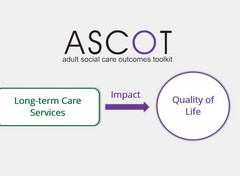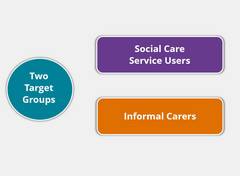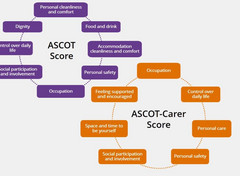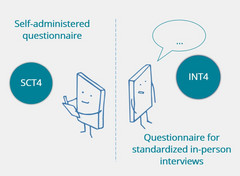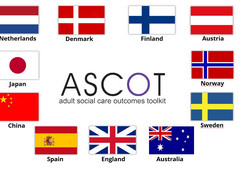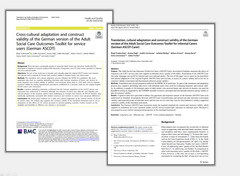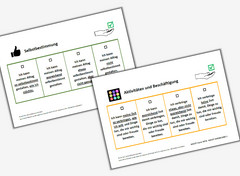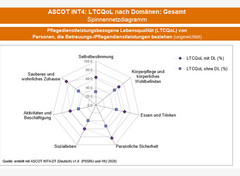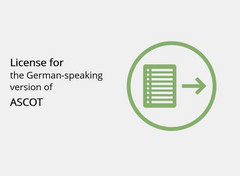ASCOT (German Version)
I- About ASCOT
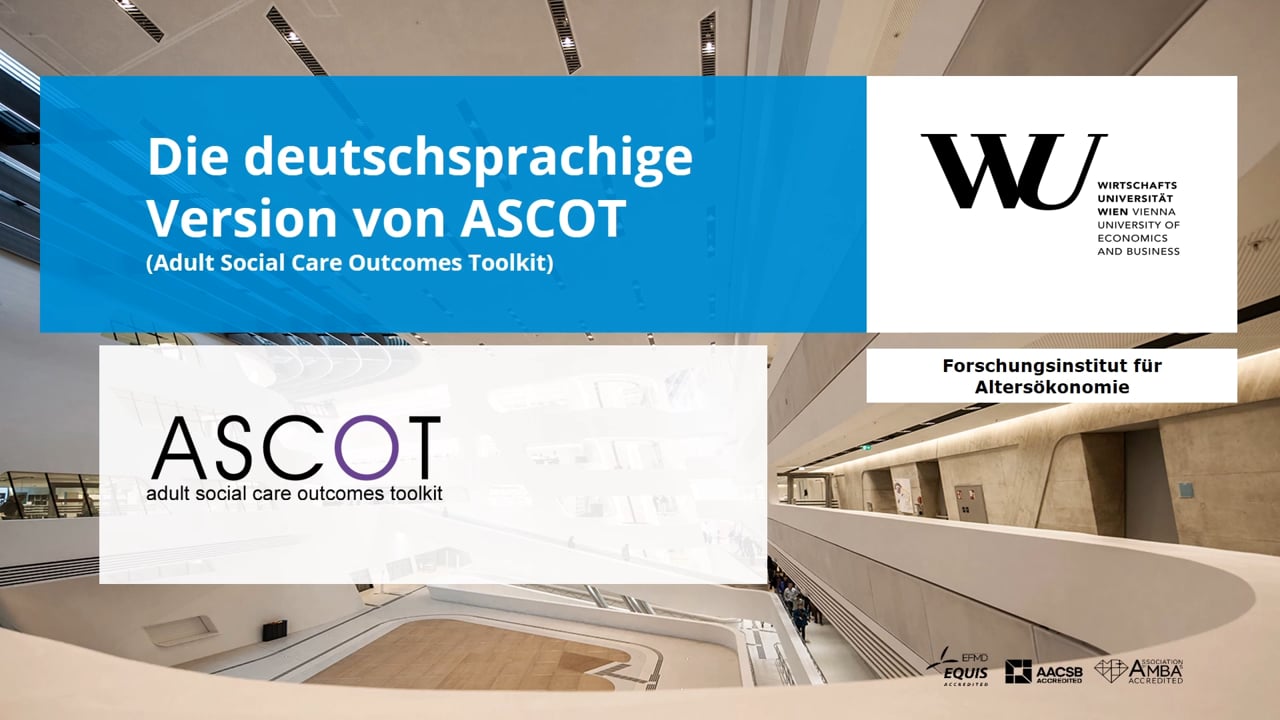
Die deutschsprachige Version von…
1. What is ASCOT?
2. What is special about ASCOT?
3. Who developed ASCOT? Who translated ASCOT into German?
II - The German version of the ASCOT instruments
4. Which instrument is best suited for my purpose? What does SCT4 and INT4 mean?
5. For which target groups can the German version of the ASCOT instruments be used?
6. Does ASCOT exist in easy language?
7. Does the use of the ASCOT data collection tools require a training of the fieldworkers?
8. What do German ASCOT survey instruments look like?
9. Are there Showcards that support data collection?
III - The ASCOT results and data tools
10. How can ASCOT results be presented?
11. Is there a tool that supports data analysis?
12. What publications are currently available for the German version of ASCOT?
IV - Using the German version of ASCOT
13. Can I use the German version of ASCOT in other projects?
14. Can the German version of ASCOT be used with (online) survey software and/or integrated in data collections using other instruments?
15. Can I change the order or amend the wording of the ASCOT questions and/or response options?
16. Can I include any German ASCOT survey instruments (full set of questions) in publications?
17. How should the copyright notice be integrated into surveys using the German version of ASCOT?
18. Which references should be included when publishing data that was collected using the German version of ASCOT?
19. Which references should be included when publishing results generated by using the ASCOT Data Tool (ASCOT-DT)?
V - Licence for using ASCOT
20. Is a licence absolutely necessary to use ASCOT?
21. How do I get a licence to use the German version of ASCOT?
22. How do I get a licence for ASCOT in a language other than German?
VI - Contact
23. ASCOT Team
1. What is ASCOT?
ASCOT (Adult Social Care Outcomes Toolkit) is composed of a set of survey instruments that be can be used to measure the specific quality of life of adult people (18 years and older) that may be affected by care service provision.
ASCOT aims to improve the assessment and measurement of outcomes of long-term care service provision.
The ASCOT survey instruments were developed in order to study the effects of care services on the quality of life of service users and their informal carers.
With ASCOT, the following questions can be answered:
What is the quality of life of ...
people using care services?
informal carers (relatives and non-kin) of care service users?
How do care services impact on ...
service users’ quality of life?
informal carers (relatives and non-kin) quality of life?
In which areas of life ...
do care services (and/or services for informal carers) impact on quality of life?
is there room for improvement?
2. What is special about ASCOT?
3. Who developed ASCOT? Who translated ASCOT into German?
ASCOT (Adult Social Care Outcomes Toolkit) was developed by the PSSRU (Personal Social Service Research Unit) at the University of Kent (England, U.K.). As part of the EXCELC (“Exploring Comparative Effectiveness and Efficiency in Long-Term Care”) project, the ASCOT team at the WU Vienna University of Economics and Business (Austria), in cooperation with Corporate Translations, Inc., translated ASCOT into German. The PSSRU’s ASCOT team at the University of Kent authorised the translation and advised the Austrian translation team throughout the process.
The ASCOT team at the Vienna University of Economics and Business (WU) is led by Dr Birgit Trukeschitz (WU Research Institute for the Economics of Aging); Assma Hajji, Judith Kieninger, Judith Litschauer, Tobias Krüse, Adiam Schoch and Meika Sternkopf assisted with the translation, cultural adaptation (including cognitive interviews) and/or contributed to validate the translated instruments.
4. Which instrument is best suited for my purpose? What does SCT4 and INT4 mean?
The German version of the ASCOT survey intruments for the assessment of the quality of life is available for two target groups
people using care services
- who can complete the original questionnaire
- who might prefer to read texts in easy language (for example, due to reading or comprehension difficulties)informal carers (relatives and non-kin) of care service users
There are 2 versions of survey instruments for each of these target groups:
as self-completion tool (or “SCT4” for short) and
as standardized personal interview (or “INT4”for short). This version includes the associated ASCOT-Showcards which function as guideline in the interview process
The two versions differ not only in their use, but also in their scope. The decision as to which ASCOT survey instrument is best to use depends on the survey method and the objective of the data collection.
The ASCOT-Instrumentfinder sums up the possibilities and facilitates the choice.
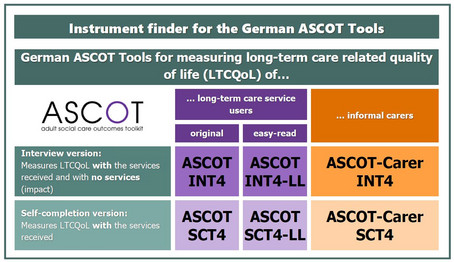
5. For which target groups can the German version of the ASCOT instruments be used?
Care service users: ASCOT SCT4/INT4
The ASCOT SCT4 and ASCOT INT4 questionnaires can be used to determine the quality of life of people who receive care services. These survey instruments each cover 8 areas of life (“domains”):
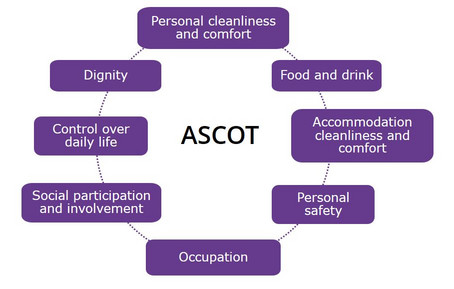
For a definition of the ASCOT domains in German, see Trukeschitz et al. 2018.
Informal carers (relatives, friends, neighbours): ASCOT-Carer SCT4/INT4:
With the ASCOT-Carer SCT4 and ASCOT-Carer INT4 questionnaire set, the quality of life of informal carers (relatives and non-kin) is assessed. These survey instruments each cover 7 areas of life (“domains”):
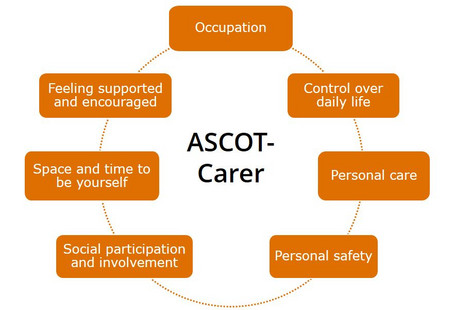
For a definition of the ASCOT-Carer domains in German, see Trukeschitz et al. (2018).
6. Does ASCOT exist in easy language?
Yes. For people receiving care services who have difficulty reading conventional texts, easy-to-read versions of the respective instruments are also available. These are written in simplified language with a clear outline, have a larger font, and include illustrations to aid comprehension. ASCOT SCT4-LL is the easy-to-read version of the ASCOT questionnaire for self-completion, ASCOT INT4-LL is the easy-to-read version of the ASCOT interview version.
7. Does the use of the ASCOT data collection tools require a training of the fieldworkers?
SCT4; INT4: It is possible to administer the ASCOT versions SCT4 und INT4 without training the fieldworkers in data collection.
CH3: data collection using ASCOT CH3 requires a training of the fieldworkers by the ASCOT team. This training is currently provided by the ASCOT team at the University of Kent in English only.
8. What do the German ASCOT survey instruments look like?
Below you will find samples from the German ASCOT survey instruments. The complete survey instrument can only be viewed after receiving a license (see below).
SCT4 – The self-completion questionnaire.
ASCOT SCT4 instrument for people who receive care/support services
the sample shows three out of eight questions
ASCOT SCT4-LL (deutsch) easy-to-read version instrument for people who receive care/support services
the sample shows three out of seven questions
ASCOT-Carer SCT4 instrument for informal carers
the sample shows three out of seven questions
INT4 – Version for a standardized personal interview.
ASCOT INT4 instrument for people who receive care/support services
the first sample shows the first page of the introduction
the second sample shows the three questions of the domain "Control over daily life" (each of the eight domains has three questions)
ASCOT INT4-LL (deutsch) easy-to-read version instrument for people who receive care/support services
the first sample shows one of the 7 domains
the second sample shows the showcards to the domain
ASCOT Carer INT4 instrument for informal carers
the first sample shows the first page of the introduction
the second sample shows the three questions of the domain "Occupation" (each of the seven domains has three questions)
ASCOT Showcards: The licence for the interview versions (ASCOT-INT4 and ASCOT-Carer INT3) includes the corresponding ASCOT-Showcards
Sample Showcard for ASCOT-INT4
sampler for ASCOT-INT4-L
Sample Showcard for ASCOT-Carer INT4
An explanation of the ASCOT-Showcard can be found here.
9. Are there Showcards that support data collection?
Yes, if you use the interview version of ASCOT (ASCOT INT4, ASCOT INT4-LL and/or ASCOT-Carer INT4), you can facilitate the data collection with the ASCOT showcards. The ASCOT showcards present the possible answers to questions about quality of life in large letters on a size A4 page. The presentation and layout of the showcards was chosen to improve their readability and to simplify the differentiation of the possible answers. Therefore, symbols are used to denote the domains of quality of life that are addressed in the interview and to specify whether the question relates to the situation with or without care services.
You will receive the ASCOT showcards together with the corresponding survey instruments and will be able to access the showcards as long as you have a valid license for the ASCOT survey instruments (ASCOT INT4, ASCOT INT4-LL and/or ASCOT-Carer INT4). Please note that the ASCOT showcards are meant to assist with data collection; thus, any other use is not permitted without the consent of the ASCOT team at the WU.
Samples of the ASCOT-Showcards can be found here.
10. How can ASCOT results be presented?
There are several options for descriptive presenting the results of the data collected with ASCOT:
a) Presentation of the ASCOT quality of life areas (domains):
ASCOT Bar Chart
If you have collected data using the SCT4 version of ASCOT (self-completion questionnaire), you can map the individual’s current quality of life (with care services). The current QoL reflects the individual’s situation with the care services they are receiving (status quo).
If you have collected data using the INT4 version of ASCOT (for standardized personal interviews), in addition to the status quo, you can also map the quality of life that would be expected if the respondents did not receive any care services.
For Austria, the ASCOT result display (in the form of bar graphs) looks as follows:
![[Translate to English:] ASCOT Balkendiagramm Österreich](/fileadmin/wu/_processed_/6/0/csm_ASCOT_Balkendiagramm_%C3%96sterreich_finale_d3e625e30d.png)
ASCOT-DT supports depicting results in form of bar charts and other diagrams.
ASCOT Spider-web diagram
The ASCOT Spider-web diagram has the advantage that – if data were collected with the INT4 version of ASCOT – both values (the status quo and the expected quality of life without care service) can be displayed jointly in one graph. In addition, the effect of the care services on the domains of quality of life can be read directly from the graph. For Austria, the result display (in the form of an ASCOT Spider-web diagram) looks as follows:
![[Translate to English:] ASCOT Spinnennetzdiagramm Österreich](/fileadmin/wu/_processed_/e/0/csm_ASCOT-Spinnennetzdiagramm_%C3%96sterreich_final_d947d503f4.png)
ASCOT-DT supports depicting results in form of spider-web charts and other diagrams.
b) Calculation of the ASCOT score (SCRQoL/LTCQoL):
The ASCOT score reflects the individual’s overall quality of life over all ASCOT domains. In English publications, the terms “social care related quality of life (SCRQoL)” or “long-term care related quality of life (LTCQoL)” are used.
The ASCOT score can be calculated for the status quo of quality of life (when using the INT4 or the SCT4 versions). In the case of data collected with the INT4 version of ASCOT, the ASCOT score can also be calculated for the expected quality of life, which captures the quality of life in the hypothetical case of the absence of care services. Therefore, it is possible to use these two values to determine the effect or impact of the care service(s) on the quality of life.
There are two methods available for calculating the ASCOT scores:
For the ASCOT score, domain-specific scores are summed up for each respondent and rescaled to lie between zero and one (unweighted ASCOT score). Alternatively, preference weights can be used instead of the raw domain-specific scores (weighted ASCOT score). ASCOT scores with preference weights take into account that the conditions associated with the different areas of quality of life may differ in importance. For example, an ideal state in the “food and drink” domain is not necessarily as important (or “valued” as much) as an ideal state in the “control over daily life” domain. This attributed value is, therefore, reflected in the preference weights. While the unweighted ASCOT score assumes that all domains are equally important, the weighted ASCOT score also takes into account the preference of the population. The choice of the score (weighted or unweighted) is thus dependent on the research question.
ASCOT-DT supports calculation of the ASCOT score.
11. Is there a tool that supports data analysis?
ASCOT Data Tool (ASCOT-DT) for Support of Data Evaluation (all ASCOT survey instruments)
The data has been collected, so now what? In order to help visualize your results, the ASCOT data tool (ASCOT-DT) can assist you with the creation of figures and tables. The tool has been developed for use with the original ASCOT, but can also be used for data collected with the easy-read version (ASCOT-LL). As soon as you have entered the data collected with the ASCOT instruments in the worksheet, you will be able to view an overview of your sample (age, gender), the ASCOT scores, bar and spider web charts, and a detailed table with all of the values. If necessary, you can also generate diagrams, which split the analysis by gender. The ASCOT-DT is easy to use and primarily intended for those who do not want to use statistical programs.
The ASCOT-DT is included in your license for the survey instruments.
User Guides explain how to use the ASCOT-Data Tools. All user guides can be downloaded free of charge.
User Guides for the analysis of long-term care service user data
ASCOT-INT4 – Interview-Version
ASCOT-SCT4 – Fragebogen-Version
User Guides for the analysis of informal carer data
ASCOT-Carer INT4 – Interview-Version
Video for the use of ASCOT Data Tools (German only)
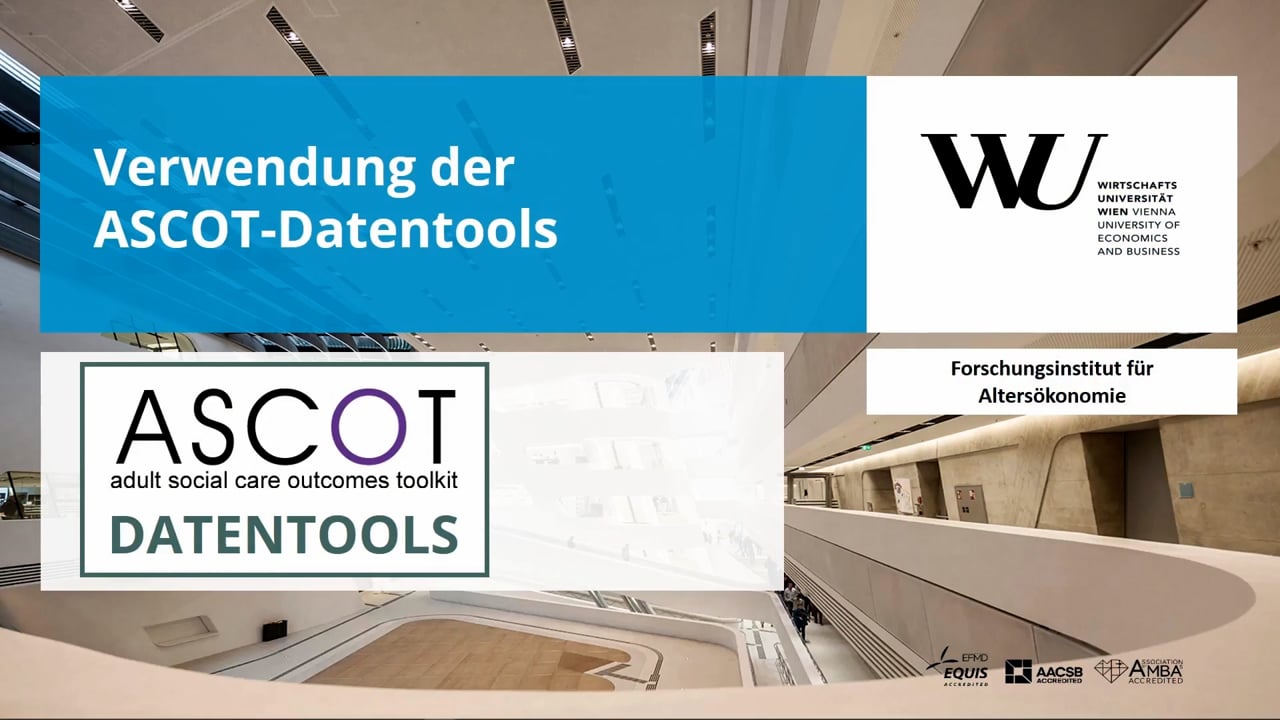
Verwendung der…
Verwendung der ASCOT-Datentools
Video for entering data in the ASCOT Data Tools (German only)
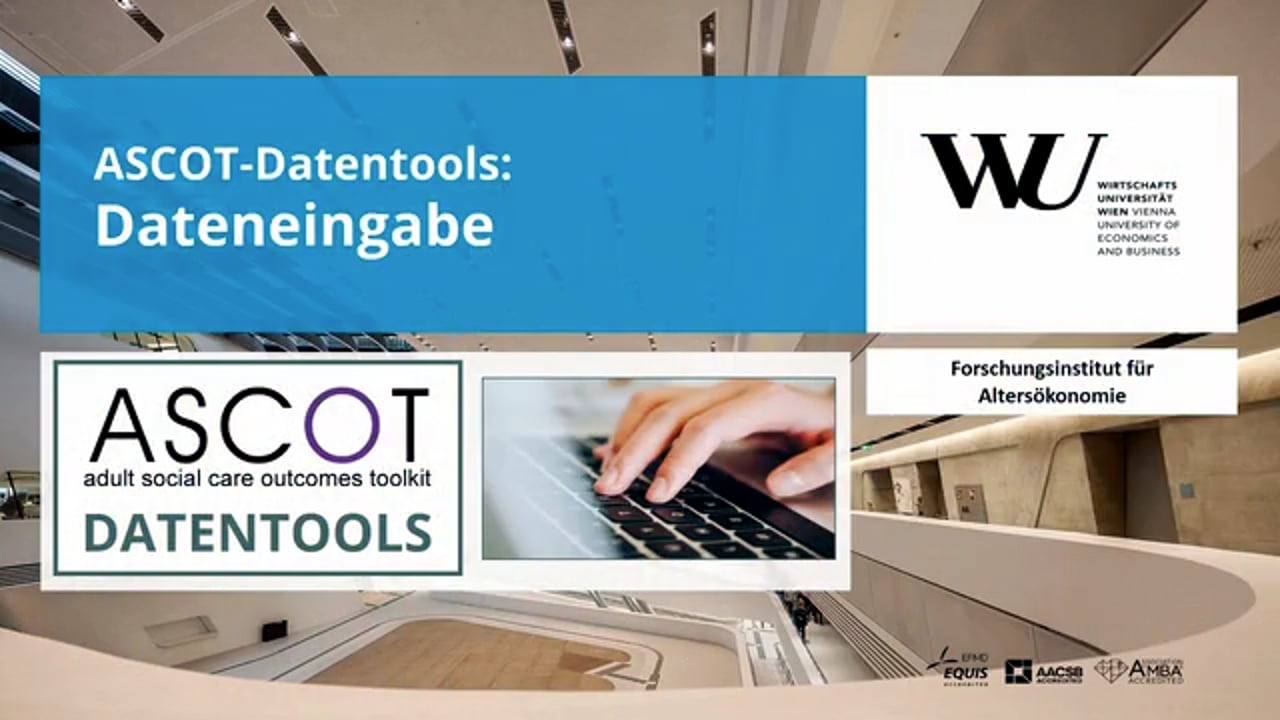
ASCOT-Datentools Dateneingabe
ASCOT-Datentools Dateneingabe
12. What publications are currently available for the German version of ASCOT?
Translation into German and construct validity of the German ASCOT
Trukeschitz Birgit, Litschauer Judith, Hajji Assma, Kieninger Judith, Schoch Adiam, Malley Juliette, Rand Stacey, Linnosmaa Ismo and Forder Julien (2020) Cross-Cultural Adaptation and Construct Validity of the German Version of the Adult Social Care Outcomes Toolkit for Service Users (German ASCOT). Health and Quality of Life Outcomes, 18:326, 1-19
Translation into German and construct validity of the German ASCOT-Carer
Trukeschitz, Birgit; Hajji, Assma; Litschauer, Judith; Malley, Juliette; Schoch, Adiam; Rand, Stacey; Linnosmaa, Ismo; Forder, Julien (2021) Translation, Cultural Adaptation and Construct Validity of the German Version of the Adult Social Care Outcomes Toolkit for Informal Carers (German ASCOT-Carer). Quality of Life Research, 30: 905-920: https://doi.org/10.1007/s11136-020-02682-4
Quality of life of home care service users – summary of results for Austria:
Pfabigan, Doris. 2023. Lebensqualität pflegebedürftiger Menschen im Fokus – nur etwas für gute Zeiten? Pflege Professionell - Das Fachmagazin, 2023 (31), 19-26 (Article in German only)
Pfabigan, Doris. 2023. Lebensqualität in der Langzeitpflege - „Es braucht nicht mehr- es braucht anderes“. Pflege Professionell - Das Fachmagazin, 2023 (31), 27-31 (Article in German only)
Hajji, Assma; Trukeschitz, Birgit. 2023. Pflegebezogene Lebensqualität messen mit ASCOT: für jeden Einsatzzweck das richtige Erhebungsinstrument. Pflege Professionell - Das Fachmagazin, 2023 (31), 33-37 (Article in German only)
Trukeschitz, Birgit; Hajji, Assma; Litschauer, Judith; Kieninger, Judith; Linnosmaa, Ismo.2018. Wie wirken sich Pflegedienste auf die Lebensqualität aus? [How do care services affect quality of life?] Trendreport 1/2018, 20.06.18 (Report in German only)
Factors influencing the effects of home care services on service users’ quality of life in Austria, England and Finland
Trukeschitz, Birgit; Hajji, Assma; Kieninger, Judith; Malley, Juliette; Linnosmaa, Ismo; and Forder, Julien (2021) Investigating factors influencing quality-of-life effects of home care services in Austria, England, and Finland: a comparative analysis. European Journal of Social Policy: 31 (2), 192-208, https://doi.org/10.1177/0958928720974189
NEW: Factors influencing the effects of home care services on care givers’ quality of life in Austria, England and Finland
Linnosmaa, I., Nguyen, L., Jokimäki, H., Saloniki, E.-C., Malley, J., Trukeschitz, B., Hajji, A ., Forder, J. (2024). Quality of life outcomes for informal carers of long-term care service users in Austria, England and Finland. Quality of Life Research, 33(9), 2477-2488. doi:10.1007/s11136-024-03711-2
Which areas of life are important to people in Austria in case of care dependency (preference weights for ASCOT SCT4 and INT4 for Austria):
Hajji, Assma; Trukeschitz, Birgit; Malley, Juliette; Batchelder, Laurie; Saloniki, Elrini; Linnosmaa, Ismo; Lu, Hui.2020. Population-based preference weights for the Adult Social Care Outcomes Toolkit (ASCOT) for service users for Austria: Findings from a best-worst experiment. Social Science and Medicine. 250 (112792), 1-10.
Which areas of life are important to people in Austria in case of caring for a relative (preference weights for ASCOT-Carer SCT4 and INT4 for Austria):
Trukeschitz, Birgit; Hajji, Assma; Batchelder, Laurie; Saloniki, Eirini; Linnosmaa, Ismo; Malley, Juliette. (2021). What’s important when caring for a loved one? Population-based preference weights for the Adult Social Care Outcomes Toolkit for informal carers (ASCOT-Carer) for Austria, Quality of Life Research, https://doi.org/10.1007/s11136-021-02775-8.
EXCELC-ASCOT INT4: study design and descriptives - Austria
Trukeschitz Birgit, Litschauer Judith, Kieninger Judith, Hajji Assma, and Schoch Adiam (2018): Study Design and Descriptive Statistics for the Austrian Sample of Adult Users of Home Care Services, EXCELC-Discussion Paper No. 2/2018 and Discussion Paper No. 4/2018 of the WU Research Institute for Economics of Aging, Vienna University of Economics and Business, Austria.
EXCELC-ASCOT-Carer INT4: study design and descriptives - Austria
Trukeschitz Birgit, Litschauer Judith, Kieninger Judith, Hajji Assma, and Schoch Adiam (2018): Study Design and Descriptive Statistics for the Austrian Sample of Informal Carers, EXCELC-Discussion Paper No. 3/2018 and Discussion Paper No. 5/2018 of the WU Research Institute for Economics of Aging, Vienna University of Economics and Business, Austria.
13. Can I use the German version of ASCOT in other projects?
No. ASCOT may only be used for the project / study or purpose for which the licence was granted. If you want to use ASCOT for other projects, studies or purposes, you have to apply for a new licence.
14. Can the German version of ASCOT be used with (online) survey software and/or integrated in data collections using other instruments?
Yes. Both the use of (online) survey software and the integration of ASCOT questionnaires in multi-topic surveys is allowed. We would also strongly advise that you keep the ASCOT questions as a block of questions and do not change their order. For information on how to incorporate the copyright notice, see here.
15. Can I change the order or amend the wording of the ASCOT questions and/or response options?
No. The original English version and the culturally adapted German version of ASCOT have been tested thoroughly. Making changes to these will jeopardise the validity and integrity of the survey instruments.
16. Can I include any German-language ASCOT survey instruments (full set of questions) in publications?
No. The developers and translator of ASCOT wish the instruments to be used widely in long-term care settings to promote an outcomes approach in long-term care practice, policy and research. However, it is important that any quotations of the ASCOT questions in publications do not violate the intellectual property, which belongs to the developers (members of the Personal Social Services Unit at the University of Kent) and the translator into German (WU Vienna). Therefore, including the full ASCOT instruments (e.g. a complete set of questions from the ASCOT SCT4/ASCOT-Carer SCT4 or ASCOT INT4/ASCOT-Carer INT4) in publications would be considered a breach of the copyright and intellectual property.
Authors should provide a fair and reasonable representation of the ASCOT instruments used in their research or practice. Quoting the first and the last ASCOT domain will give the reader a good understanding of the ASCOT.
ASCOT: “Control over daily life“ und „Dignity"
ASCOT-Carer: “Occupation” und “Feeling encouraged and supported“
These requirements for representing the German version of ASCOT also apply for publications in English. Please note that in English publications the wording of the original English ASCOT survey instruments has to be used (no separate translation from German into English).
17. How should the copyright notice be integrated into surveys using the German version of ASCOT?
Use of the original paper questionnaires of German version of ASCOT
If you use the original paper questionnaires of the German version of ASCOT, the following copyright notice in German is already included on the last page (here the example for ASCOT SCT4):
“© 2020 WU, Wirtschaftsuniversität Wien (autorisierte Übersetzung des englischen Originals ASCOT-Carer INT4; © University of Kent. Alle Rechte vorbehalten)
Der Adult Social Care Outcomes Toolkit (ASCOT), zu dem dieses Erhebungsinstrument gehört, wurde von MitarbeiterInnen der Personal Social Services Research Unit (PSSRU) der University of Kent entwickelt. Dieses Erhebungsinstrument wurde vom ASCOT-Team der Wirtschaftsuniversität Wien (WU) ins Deutsche übersetzt. Die Wirtschaftsuniversität Wien (WU) ist Eigentümerin des Urheberrechts an der deutschen Übersetzung von ASCOT.
Die nicht-kommerzielle Nutzung der deutschsprachigen Version von ASCOT ist kostenfrei, jedoch ist eine Lizenz erforderlich. Die kommerzielle Nutzung der deutschsprachigen Version von ASCOT ist mit einer Gebühr verbunden. Für Informationen, wie eine Lizenz zu erhalten ist und bei weiteren Fragen, wenden Sie sich bitte an das ASCOT-Team der Wirtschaftsuniversität Wien (ascot-deutsch@wu.ac.at).
Die University of Kent und die Wirtschaftsuniversität Wien behalten sich das Recht vor, gegen eine unautorisierte und unlizenzierte Verwendung der deutschsprachigen Version von ASCOT vorzugehen, unabhängig davon, ob es sich um eine kommerzielle oder nicht-kommerzielle Verwendung von ASCOT handelt.“
Multi-topic surveys and use of the German ASCOT instruments in an online-survey software:
If the German version of ASCOT is integrated into a survey that has several topics, the beginning of the ASCOT questions must be clearly marked with the heading “ASCOT” and at least the short copyright notice (see below) must be included at the end of the ASCOT section of the survey (example for ASCOT-Carer SCT4):
“© 2020 WU, Wirtschaftsuniversität Wien (autorisierte Übersetzung des englischen Originals ASCOT-Carer INT4; © University of Kent. Alle Rechte vorbehalten)
In order to ensure that respondents are not influenced or distracted, we recommend including the entire copyright notice at the end of the survey, along with any other references or copyright notices. This procedure also applies to data collection with online-survey software.
18. Which references should be included when publishing data that was collected using the German version of ASCOT?
If you publish results that contain data collected using one of the German versions of the ASCOT survey instruments, please refer to the following references:
General ASCOT:
Netten A, Burge P, Malley J, Potoglou D, Towers A, Brazier J, Flynn T, Forder J, Wall B (2012) Outcomes of Social Care for Adults: Developing a Preference-Weighted Measure, Health Technology Assessment, 16, 16, 1-165 .
German version of ASCOT SCT4 and INT4:
Trukeschitz, Birgit; Litschauer, Judith; Hajji, Assma; Kieninger, Judith; Schoch, Adiam; Malley, Juliette; Rand, Stacey; Linnosmaa, Ismo and Forder, Julien (2020) Cross-Cultural Adaptation and Construct Validity of the German Version of the Adult Social Care Outcomes Toolkit for Service Users (German ASCOT), Health and Quality of Life Outcomes, 18:326, 1-19
If you have used ASCOT Showcards in interviews with care service users:
WU und PSSRU (2020): ASCOT INT4-SHOWCARDS for standardized interviews with people who receive care/nursing services, WU Research Institute for the Economic of Ageing, Vienna University of Economics and Business.
German version of ASCOT-Carer SCT4 and INT4:
Trukeschitz, Birgit; Hajji, Assma; Litschauer, Judith; Malley, Juliette; Schoch, Adiam; Rand, Stacey; Linnosmaa, Ismo; Forder, Julien (2020) Translation, Cultural Adaptation and Construct Validity of the German Version of the Adult Social Care Outcomes Toolkit for Informal Carers (German ASCOT-Carer)
Quality of Life Research (2020): https://doi.org/10.1007/s11136-020-02682-4.
If you have used ASCOT-Carer Showcards in interviews with informal carers:
WU und PSSRU (2020): ASCOT INT4-SHOWCARDS for standardized interviews with informal carers, WU Research Institute for the Economics of Ageing, Vienna University of Economics and Business.
Descriptions of the quality-of-life domains of the German ASCOT and the German ASCOT-Carer
Trukeschitz, Birgit; Hajji, Assma; Litschauer, Judith; Kieninger, Judith; Linnosmaa, Ismo. 2018. How do care services affect quality of life? Trendreport 1/2018, 20.06.18
ASCOT preference weights for Austria to calculate the quality-of-life scores of care service users:
Hajji, Assma; Trukeschitz, Birgit; Malley, Juliette; Batchelder, Laurie; Saloniki, Eirini; Linnosmaa, Ismo; Lu, Hui.2020. Population-based preference weights for the Adult Social Care Outcomes Toolkit (ASCOT) for service users for Austria: Findings from a best-worst experiment. Social Science and Medicine. 250 (112792), 1-10.
ASCOT-Carer preference weights for Austria to calculate the quality-of-life scores for informal carers:
NEW: Trukeschitz, Birgit; Hajji, Assma; Batchelder, Laurie; Saloniki, Eirini; Linnosmaa, Ismo; Malley, Juliette. (2021). What’s important when caring for a loved one? Population-based preference weights for the Adult Social Care Outcomes Toolkit for informal carers (ASCOT-Carer) for Austria, Quality of Life Research, https://doi.org/10.1007/s11136-021-02775-8.
19. Which references should be included when publishing results generated by using the ASCOT Data Tool (ASCOT-DT)?
With the ASCOT Data Tool, you can easily calculate ASCOT scores and compile tables and graphs. A specific Data Tool is available for each of the ASCOT survey instruments, meaning there are four ASCOT-DTs in total (one for each of the following: ASCOT INT4, ASCOT SCT4; ASCOT-Carer INT4, and ASCOT Carer SCT4).
If you want to publish results taken from one of the ASCOT Data Tools, please provide a citation to the corresponding ASCOT-DT.
In the following examples, we refer to the ASCOT-INT4-DT, meaning the ASCOT Data Tool for data collected using the interview version of the ASCOT for care service users. Please make sure to use the correct title and version number of the ASCOT-Data Tool in your citations (you can find both in the name of the Excel sheet).
Note as part of tables and figures created with ASCOT-DT:
Tables and figures created using the ASCOT-DT already have the correct sources included.
Example:
„Source: created using ASCOT INT4-DT (Deutsch) v1.1 (PSSRU and WU 2021)“
Running text for tables and figures created with ASCOT-DT:
Example:
“All graphs using ASCOT data were created using the ASCOT INT4-DT (Deutsch) v1.1 (PSSRU and WU 2021).”
List of references for tables and figures created with ASCOT-DT:
Example:
„PSSRU and WU (2021): ASCOT Data Tool for the German version of ASCOT INT4 (ASCOT INT4-DT), Release 1.1, latest version amended by WU, Vienna: Vienna University of Economics and Business.“
20. Is a licence absolutely necessary to use ASCOT?
Yes. A licence is required to use the German version of ASCOT.
The German version of ASCOT is the intellectual property of the University of Kent and the WU, and is protected by copyright. With the license, the WU grants the licensees permission to use the German version of ASCOT.
The license also specifies the conditions under which the German version of ASCOT may be used. For example, the wording of the questions / answers must not be changed. The terms of use are based on the guidelines agreed with the University of Kent.
A license thus enables interested organizations and persons under certain conditions to use the German ASCOT survey instruments and associated materials (such as the ASCOT Data Tool or the ASCOT-Showcards).
21. How do I get a licence to use the German version of ASCOT?
A licence is required to use the German version of ASCOT. Please note that the licence is only ever granted for a specific (research) project or study.
In addition, these terms and conditions apply to the use of the German version of ASCOT.
The licence for the non-commercial use of the German version of ASCOT is free of charge. In this case, non-commercial use means that the German version of ASCOT is used for the benefit of the public without financial gain. Examples of non-commercial use include but are not limited to non-commercial research projects or care organizations in the nonprofit sector or the public sector.
For the commercial use of the German version of ASCOT, a fee is required. In this context, commercial use includes but is not limited to any use that supports the generation of revenue or use by for-profit organisations. For information on the licence fee, please contact ascot-deutsch@wu.ac.at.
In the case that it is unclear whether the proposed use of ASCOT requires a commercial or non-commercial licence, please first contact WU (ascot-deutsch@wu.ac.at) before applying for a licence. Please provide details on the planned use, on the proposed project/study and on the organisation applying for the licence.
Online registration form
If you would like to obtain a licence for the German version of ASCOT, please fill in the online registration form. Please note that this form can only be completed by a person who has the authority to consent to the terms and conditions of the ASCOT licence on behalf of their organisation.
22. How do I get a licence for ASCOT in languages other than German?
ASCOT is currently also available in English (original version), Dutch, Finnish and Japanese. For more information and on how to obtain a licence for these versions of ASCOT, see the ASCOT Website of PSSRU at the University of Kent.
back
For further information on ASCOT please see here.
![[Translate to English:]](/fileadmin/wu/_processed_/b/f/csm_104-Laptop-960_v1_8833b81630.jpg)

